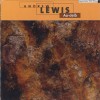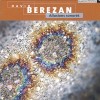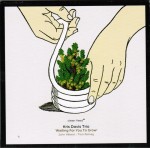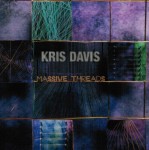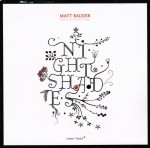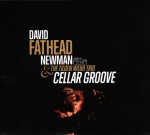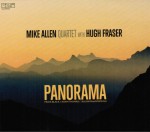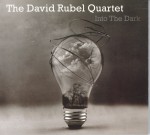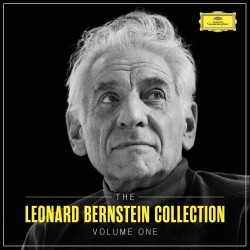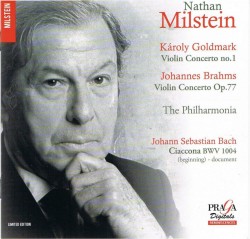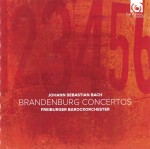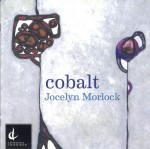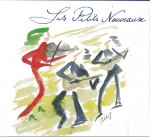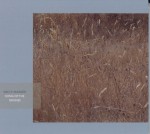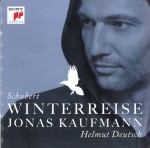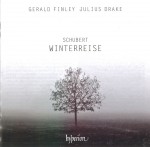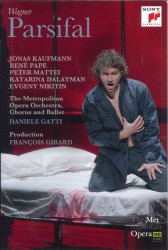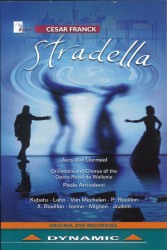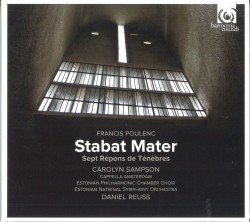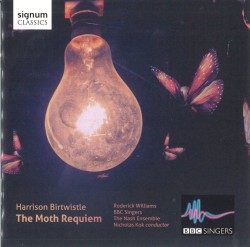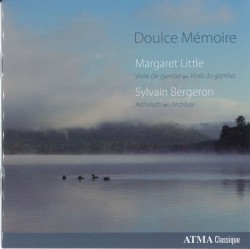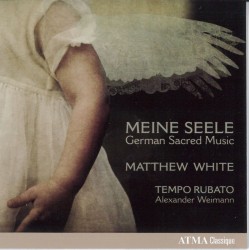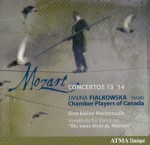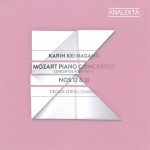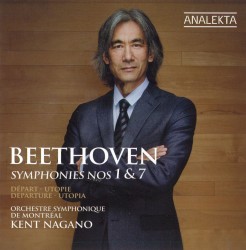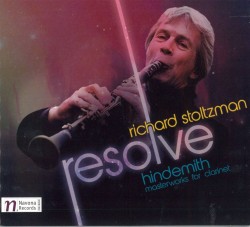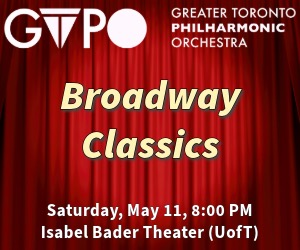As genres draw closer to one another, the idea of a musician from one area playing and composing a work in another area doesn’t seem so far-fetched. More importantly the sophistication of many contemporary performers means that these inter-genre excursions are triumphant rather than merely passable. One form that is being explored by improvising musicians for instance is composing for the bedrock of the so-called classical music tradition: string groupings.
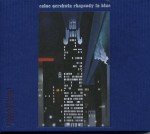 Torontonians get a chance to experience this when the Afiara Quartet joins pianist Uri Caine at Koerner Hall May 23 to play his composition for jazz piano and string quartet. Caine who has spent the past 15 years creating intriguing post-modern variants on works by, among others, Bach, Wagner and Mahler, provides a new take on tunes by early jazz-classical crossover icon George Gershwinon Rhapsody in Blue (Winter & Winter 910.205-2). Although it features only Caine, bassist Mark Helias, violinist Joyce Hammann, reedist Chris Speed, trumpeter Ralph Alessi, drummer Jim Black plus vocalists Theo Bleckmann and Barbara Walker, Caine’s take on familiar Gershwin compositions suggests the potential surprises that may result at Koerner Hall. Vocalists provide novel song interpretations, especially on a deconstructed They Can’t Take That Away from Me where yodelling and burbling is harmonized with trumpet triplets and percussion slaps. As well as operating in different metres and tempos, Caine’s solo uniquely shades How Long Has This Been Going On. But it’s the title track which is the CD’s showpiece. With an ensemble one-quarter the size of Paul Whiteman’s band which premiered the concerto in 1924, not only do Caine and company provide a sophisticated jazz sensibility, but his 22-and-a-half-minute-arrangement augments hitherto unexplored nuances in Gershwin’s score. Capturing the famous introductory glissandi, Speed’s clarinet tone includes Klezmer inflections while Alessi’s later call-and-response with the clarinetist adds Latinesque echoes and genuine emotion to the program. At one point when the trumpeter’s apex of excitedly modulated tones is coupled with pseudo-stride piano, it suggests how much more interesting Rhapsody in Blue might have been if initially performed by Louis Armstrong and James P. Johnson. True to the score, especially during Hammon’s violin parts, the sextet reaches an appropriately exciting climax at the 20-minute mark as Black’s thoroughly modern rollicking swing spurs the soloists. By the conclusion, as the underlying beat turns to a witty march rhythm, the theme is extended with jabbing keyboard lines.
Torontonians get a chance to experience this when the Afiara Quartet joins pianist Uri Caine at Koerner Hall May 23 to play his composition for jazz piano and string quartet. Caine who has spent the past 15 years creating intriguing post-modern variants on works by, among others, Bach, Wagner and Mahler, provides a new take on tunes by early jazz-classical crossover icon George Gershwinon Rhapsody in Blue (Winter & Winter 910.205-2). Although it features only Caine, bassist Mark Helias, violinist Joyce Hammann, reedist Chris Speed, trumpeter Ralph Alessi, drummer Jim Black plus vocalists Theo Bleckmann and Barbara Walker, Caine’s take on familiar Gershwin compositions suggests the potential surprises that may result at Koerner Hall. Vocalists provide novel song interpretations, especially on a deconstructed They Can’t Take That Away from Me where yodelling and burbling is harmonized with trumpet triplets and percussion slaps. As well as operating in different metres and tempos, Caine’s solo uniquely shades How Long Has This Been Going On. But it’s the title track which is the CD’s showpiece. With an ensemble one-quarter the size of Paul Whiteman’s band which premiered the concerto in 1924, not only do Caine and company provide a sophisticated jazz sensibility, but his 22-and-a-half-minute-arrangement augments hitherto unexplored nuances in Gershwin’s score. Capturing the famous introductory glissandi, Speed’s clarinet tone includes Klezmer inflections while Alessi’s later call-and-response with the clarinetist adds Latinesque echoes and genuine emotion to the program. At one point when the trumpeter’s apex of excitedly modulated tones is coupled with pseudo-stride piano, it suggests how much more interesting Rhapsody in Blue might have been if initially performed by Louis Armstrong and James P. Johnson. True to the score, especially during Hammon’s violin parts, the sextet reaches an appropriately exciting climax at the 20-minute mark as Black’s thoroughly modern rollicking swing spurs the soloists. By the conclusion, as the underlying beat turns to a witty march rhythm, the theme is extended with jabbing keyboard lines.
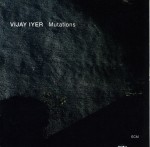 Also emphatically meeting the string-writing challenge is pianist Vijay Iyer, whose Mutations (ECM CD 2372) is based around ten compositional fragments for string quartet, piano and electronics. More prominent during the solo piano pieces which frame this chef d’oeuvre, electronics gently quiver during Mutations I-X as Iyer generously shares interpretation space with violinists Miranda Cuckson and Michi Wiancko, violist Kyle Armbrust and cellist Kivie Cahn-Lipman. Named for incremental genetic changes, the Mutations sequences are linked, but the through-composed material is structured in such a way that cerebral string improvisation is encouraged and blended both with piano cross-pulsing and recorded samples of the string playing. Concluding with a triumphant eruption of frenzied staccato string passages with an affiliated rhythm in Mutation X: Time, these Mutations cycle through many properties as they evolve. Latterly suggesting canon-like cohesion, earlier variants display skittering string harshness layered as frequently as harmonic cohesion. On Mutation IV: Chain for instance, keyboard patterning and string glissandi cross and re-cross one another following a heartbreaking solo violin interlude, saved from ur-romanticism by Carnatic-like percussion pumps from the lower-pitched strings. Tone laddering and detaching is present throughout the suite, with Iyer maintaining interest by including enough jocular and linear passages to keep the composition organically whole no matter how many sinewy string curves or processed extrusions are involved. A cohesive exploration of the possibilities available from focused composing, Mutations’ shimmering colour palate fittingly expands the steaming blues-jazz inferences in the solo piano tracks which precede and follow it.
Also emphatically meeting the string-writing challenge is pianist Vijay Iyer, whose Mutations (ECM CD 2372) is based around ten compositional fragments for string quartet, piano and electronics. More prominent during the solo piano pieces which frame this chef d’oeuvre, electronics gently quiver during Mutations I-X as Iyer generously shares interpretation space with violinists Miranda Cuckson and Michi Wiancko, violist Kyle Armbrust and cellist Kivie Cahn-Lipman. Named for incremental genetic changes, the Mutations sequences are linked, but the through-composed material is structured in such a way that cerebral string improvisation is encouraged and blended both with piano cross-pulsing and recorded samples of the string playing. Concluding with a triumphant eruption of frenzied staccato string passages with an affiliated rhythm in Mutation X: Time, these Mutations cycle through many properties as they evolve. Latterly suggesting canon-like cohesion, earlier variants display skittering string harshness layered as frequently as harmonic cohesion. On Mutation IV: Chain for instance, keyboard patterning and string glissandi cross and re-cross one another following a heartbreaking solo violin interlude, saved from ur-romanticism by Carnatic-like percussion pumps from the lower-pitched strings. Tone laddering and detaching is present throughout the suite, with Iyer maintaining interest by including enough jocular and linear passages to keep the composition organically whole no matter how many sinewy string curves or processed extrusions are involved. A cohesive exploration of the possibilities available from focused composing, Mutations’ shimmering colour palate fittingly expands the steaming blues-jazz inferences in the solo piano tracks which precede and follow it.
From Léandre’s frenzied sawing coupled with sibilant whispers to the emphasis on new roles for mass string ensembles advanced by Salamon, these sessions outline some of the paths to couple improvisation with the liberating compositions for strings. Caine will likely supply yet another concept.
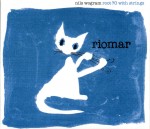 Another move away from idiomatic usage of strings as merely melody sweeteners is exhibited by German trombonist Nils Wogram, who integrates violin, viola and cello into his Root 70 quartet on Riomar (Wog Records 007). Although there are portions towards the end when the harmonizing gets a little too overripe, stabbing staccato from Matt Penman’s supple double bass on a track such as Song for Bernhard roughens the strings to give passages more texture. More generic are pieces such as Vacation without Internet and the title tune where the precarious string-band balance works imposingly. On Riomar Gareth Lubbe’s distinctively mournful viola tone sets the scene appropriately enough so that when Hayden Chisholm’s dissonant alto saxophone timbres sound, the instruments are perfectly matched. From then on, as synchronized strings quiver, solo lines from Wogram (plunger and smeary), cellist Adrian Brendel (sharp and sul ponticello), and Chisholm (spiky or mellow), extend the tunes. With drummer Jochen Rueckert limiting himself to off-beats, Vacation without Internet is even more sophisticated. Not only do the peppy string parts loop around the steady rhythm and rapid-fire bop changes from Wogram, but their other-directed arco plucking at the top combines elegance and earthiness in such a manner that it takes a while to realize that Penman has begun thumping a steady rhythm. Ironically it’s Mental Isolation (dedicated to Duke Ellington) whose spewed and strained microtonal theme elaboration provides the closest resemblance to new music. Then again Wogram’s dazzlingly tremolo tones here follow a direct line from Lawrence Brown`s mellow trombone blowing in the Ellington band.
Another move away from idiomatic usage of strings as merely melody sweeteners is exhibited by German trombonist Nils Wogram, who integrates violin, viola and cello into his Root 70 quartet on Riomar (Wog Records 007). Although there are portions towards the end when the harmonizing gets a little too overripe, stabbing staccato from Matt Penman’s supple double bass on a track such as Song for Bernhard roughens the strings to give passages more texture. More generic are pieces such as Vacation without Internet and the title tune where the precarious string-band balance works imposingly. On Riomar Gareth Lubbe’s distinctively mournful viola tone sets the scene appropriately enough so that when Hayden Chisholm’s dissonant alto saxophone timbres sound, the instruments are perfectly matched. From then on, as synchronized strings quiver, solo lines from Wogram (plunger and smeary), cellist Adrian Brendel (sharp and sul ponticello), and Chisholm (spiky or mellow), extend the tunes. With drummer Jochen Rueckert limiting himself to off-beats, Vacation without Internet is even more sophisticated. Not only do the peppy string parts loop around the steady rhythm and rapid-fire bop changes from Wogram, but their other-directed arco plucking at the top combines elegance and earthiness in such a manner that it takes a while to realize that Penman has begun thumping a steady rhythm. Ironically it’s Mental Isolation (dedicated to Duke Ellington) whose spewed and strained microtonal theme elaboration provides the closest resemblance to new music. Then again Wogram’s dazzlingly tremolo tones here follow a direct line from Lawrence Brown`s mellow trombone blowing in the Ellington band.
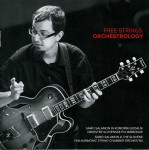 Dealing with a three-person string section is audacious enough, but Slovenian guitarist Samo Salamon has set himself a more formidable task. On Free Strings Orchestrology (KGOSF VD 013) he and drummer Roberto Dani interpret his compositions alongside the Slovene Philharmonic String Chamber Orchestra of eight violinists, three violists, two cellists and a double bassist. To be honest, dealing with 14 string players at points becomes too onerous, and the resulting synchronized tones can resemble those of a pit orchestra running through an overture. Because of the harmonic juxtaposition, at full force the string parts often produce a too familiar smoothness with waltz, tango and semi-classical inferences, and – especially when the guitarist’s licks merely advance a theme – nearly replicate a sort of James Last/Paul Mauriat lushness. Other tracks are more formal and processional, leavened by Salamon’s spidery licks, or dampened down with an overriding Mozartian classicism. Happily, improvisational toughness from Salamon and Dani rescues most of the program. For instance Mea Culpa moves along with herky-jerky glissandi from the strings and maintains a strong swing emphasis even when the melody takes on an over-familiar lilt. In complete contrast Miss Sarcasm is harsher and more percussive. Here staccato strings advance alongside clanking drums plus a guitar part that turns to bass-guitar-like thumps as it sheepdog-like herds the bow players into connective motions. Dutilleux is probably the CD’s high point, as the guitarist’s distorted timbres and fluid chording are perfectly attuned to the leaping and pulsing strings. Romantic inferences from solo violinist Janez Podlesek join the drummer’s clanking cymbals and the guitarist’s wah-wah pedal to mould the stimulating climax.
Dealing with a three-person string section is audacious enough, but Slovenian guitarist Samo Salamon has set himself a more formidable task. On Free Strings Orchestrology (KGOSF VD 013) he and drummer Roberto Dani interpret his compositions alongside the Slovene Philharmonic String Chamber Orchestra of eight violinists, three violists, two cellists and a double bassist. To be honest, dealing with 14 string players at points becomes too onerous, and the resulting synchronized tones can resemble those of a pit orchestra running through an overture. Because of the harmonic juxtaposition, at full force the string parts often produce a too familiar smoothness with waltz, tango and semi-classical inferences, and – especially when the guitarist’s licks merely advance a theme – nearly replicate a sort of James Last/Paul Mauriat lushness. Other tracks are more formal and processional, leavened by Salamon’s spidery licks, or dampened down with an overriding Mozartian classicism. Happily, improvisational toughness from Salamon and Dani rescues most of the program. For instance Mea Culpa moves along with herky-jerky glissandi from the strings and maintains a strong swing emphasis even when the melody takes on an over-familiar lilt. In complete contrast Miss Sarcasm is harsher and more percussive. Here staccato strings advance alongside clanking drums plus a guitar part that turns to bass-guitar-like thumps as it sheepdog-like herds the bow players into connective motions. Dutilleux is probably the CD’s high point, as the guitarist’s distorted timbres and fluid chording are perfectly attuned to the leaping and pulsing strings. Romantic inferences from solo violinist Janez Podlesek join the drummer’s clanking cymbals and the guitarist’s wah-wah pedal to mould the stimulating climax.
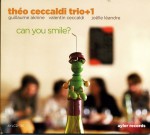 While other discs are concerned with the place of strings in advanced settlings, French violinist/violist Théo Ceccaldi goes one step further, reconstituting the most revered of European ensembles: the string quartet. On Can You Smile (Ayler Records AYLCD 136), his Trio+1 also includes guitarist Guillaume Aknine, cellist Valentin Ceccaldi and bassist Joëlle Léandre. Throughout the emphasis is on atonality, with each player doing his or her best to disrupt the proceedings at the same time as bonding during the 11 compositions. Case in point is Brosse à chaussure where sharp, sul ponticello quivers from the cellist and violist sprawl alongside the guitarist’s chromatic picking, only to mix twangs and triple stopping in an exciting conclusion. On the other hand Sirènes et bas de laine finds Léandre and Aknine strumming a continuum while tremolo glissandi from the viola replicate reed slurs. Finally Hirondelles parcels out the dissonance among all the strings, as every sequence becomes narrower and more staccato, until unexpectedly a measured combination in the final 30 seconds produces a quixotic climax. Throughout, the bassist’s florid nonsense syllable verbalization constantly mocks any high-art pretentiousness associated with a string quartet, while preserving an innate musicality. Fancifully the sounds from this Trio+1 may be what could have resulted if one of the serialists had composed for a Roma ensemble, with the added virtue of a sense of humour.
While other discs are concerned with the place of strings in advanced settlings, French violinist/violist Théo Ceccaldi goes one step further, reconstituting the most revered of European ensembles: the string quartet. On Can You Smile (Ayler Records AYLCD 136), his Trio+1 also includes guitarist Guillaume Aknine, cellist Valentin Ceccaldi and bassist Joëlle Léandre. Throughout the emphasis is on atonality, with each player doing his or her best to disrupt the proceedings at the same time as bonding during the 11 compositions. Case in point is Brosse à chaussure where sharp, sul ponticello quivers from the cellist and violist sprawl alongside the guitarist’s chromatic picking, only to mix twangs and triple stopping in an exciting conclusion. On the other hand Sirènes et bas de laine finds Léandre and Aknine strumming a continuum while tremolo glissandi from the viola replicate reed slurs. Finally Hirondelles parcels out the dissonance among all the strings, as every sequence becomes narrower and more staccato, until unexpectedly a measured combination in the final 30 seconds produces a quixotic climax. Throughout, the bassist’s florid nonsense syllable verbalization constantly mocks any high-art pretentiousness associated with a string quartet, while preserving an innate musicality. Fancifully the sounds from this Trio+1 may be what could have resulted if one of the serialists had composed for a Roma ensemble, with the added virtue of a sense of humour.
From Léandre’s frenzied sawing coupled with sibilant whispers to the emphasis on new roles for mass string ensembles advanced by Salamon, these sessions outline some of the paths to couple improvisation with the liberating compositions for strings. Caine will likely supply yet another concept.
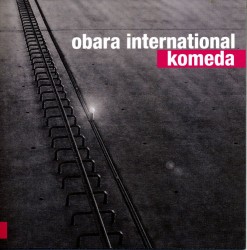 Obara International
Obara International



